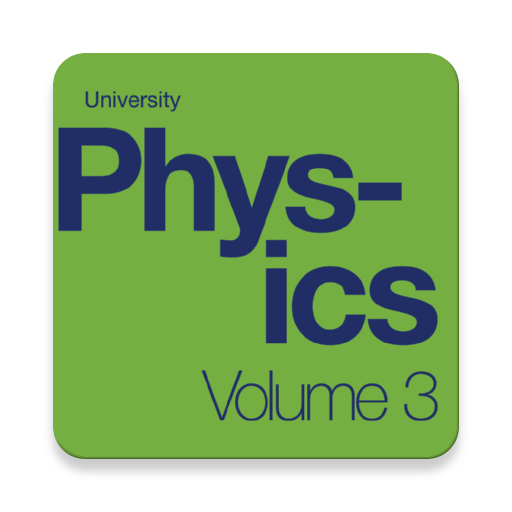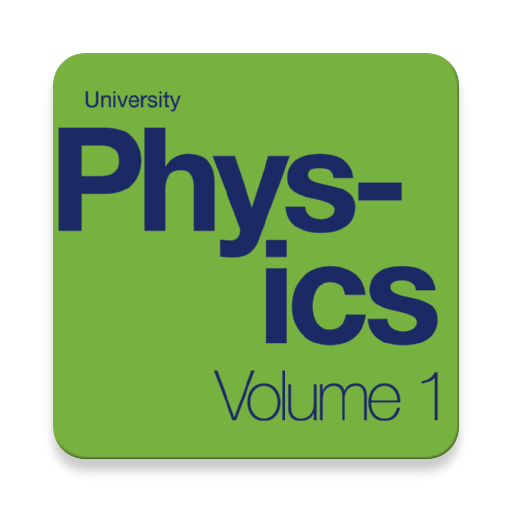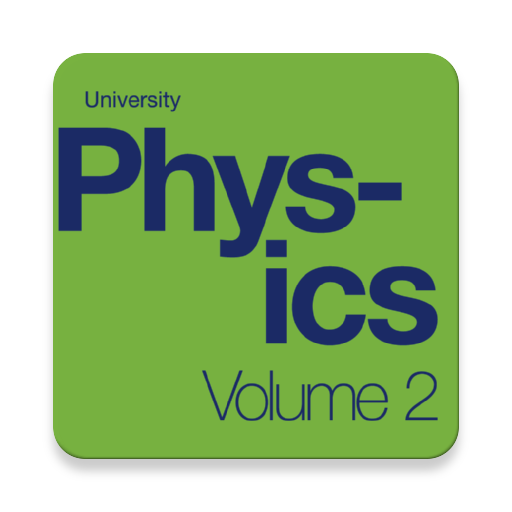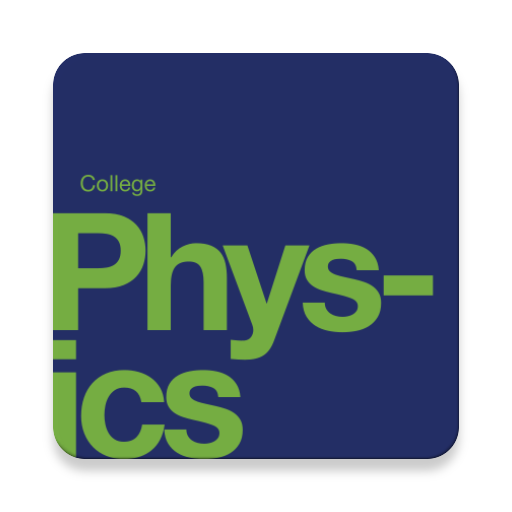

University Physics Volume 3 Textbook, Test Bank
Educational | QuizOver.com
在電腦上使用BlueStacks –受到5億以上的遊戲玩家所信任的Android遊戲平台。
Play University Physics Volume 3 Textbook, Test Bank on PC
University Physics is a three-volume collection that meets the scope and sequence requirements for two- and three-semester calculus-based physics courses.
Volume 1 covers mechanics, sound, oscillations, and waves.
Volume 2 covers thermodynamics, electricity and magnetism, and
Volume 3 covers optics and modern physics.
This textbook emphasizes connections between theory and application, making physics concepts interesting and accessible to students while maintaining the mathematical rigor inherent in the subject.
Frequent, strong examples focus on how to approach a problem, how to work with the equations, and how to check and generalize the result.
* Complete Textbook by OpenStax
* Multiple Choices Questions (MCQ)
* Essay Questions Flash Cards
* Key-Terms Flash Cards
Powered by QuizOver.com the leading online quiz creator
https://www.quizover.com
Unit 1. Optics
1. The Nature of Light
1.1. The Propagation of Light
1.2. The Law of Reflection
1.3. Refraction
1.4. Total Internal Reflection
1.5. Dispersion
1.6. Huygens’s Principle
1.7. Polarization
2. Geometric Optics and Image Formation
2.1. Images Formed by Plane Mirrors
2.2. Spherical Mirrors
2.3. Images Formed by Refraction
2.4. Thin Lenses
2.5. The Eye
2.6. The Camera
2.7. The Simple Magnifier
2.8. Microscopes and Telescopes
3. Interference
3.1. Young's Double-Slit Interference
3.2. Mathematics of Interference
3.3. Multiple-Slit Interference
3.4. Interference in Thin Films
3.5. The Michelson Interferometer
4. Diffraction
4.1. Single-Slit Diffraction
4.2. Intensity in Single-Slit Diffraction
4.3. Double-Slit Diffraction
4.4. Diffraction Gratings
4.5. Circular Apertures and Resolution
4.6. X-Ray Diffraction
4.7. Holography
Unit 2. Modern Physics
5. Relativity
5.1. Invariance of Physical Laws
5.2. Relativity of Simultaneity
5.3. Time Dilation
5.4. Length Contraction
5.5. The Lorentz Transformation
5.6. Relativistic Velocity Transformation
5.7. Doppler Effect for Light
5.8. Relativistic Momentum
5.9. Relativistic Energy
6. Photons and Matter Waves
6.1. Blackbody Radiation
6.2. Photoelectric Effect
6.3. The Compton Effect
6.4. Bohr’s Model of the Hydrogen Atom
6.5. De Broglie’s Matter Waves
6.6. Wave-Particle Duality
7. Quantum Mechanics
7.1. Wave Functions
7.2. The Heisenberg Uncertainty Principle
7.3. The Schrӧdinger Equation
7.4. The Quantum Particle in a Box
7.5. The Quantum Harmonic Oscillator
7.6. The Quantum Tunneling of Particles through Potential Barriers
8. Atomic Structure
8.1. The Hydrogen Atom
8.2. Orbital Magnetic Dipole Moment of the Electron
8.3. Electron Spin
8.4. The Exclusion Principle and the Periodic Table
8.5. Atomic Spectra and X-rays
8.6. Lasers
9. Condensed Matter Physics
9.1. Types of Molecular Bonds
9.2. Molecular Spectra
9.3. Bonding in Crystalline Solids
9.4. Free Electron Model of Metals
9.5. Band Theory of Solids
9.6. Semiconductors and Doping
9.7. Semiconductor Devices
9.8. Superconductivity
10. Nuclear Physics
10.1. Properties of Nuclei
10.2. Nuclear Binding Energy
10.3. Radioactive Decay
10.4. Nuclear Reactions
10.5. Fission
10.6. Nuclear Fusion
10.7. Medical Applications and Biological Effects of Nuclear Radiation
11. Particle Physics and Cosmology
11.1. Particle Conservation Laws
11.2. Quarks
11.3. Particle Accelerators and Detectors
11.4. The Standard Model
11.5. The Big Bang
11.6. Evolution of the Early Universe
Volume 1 covers mechanics, sound, oscillations, and waves.
Volume 2 covers thermodynamics, electricity and magnetism, and
Volume 3 covers optics and modern physics.
This textbook emphasizes connections between theory and application, making physics concepts interesting and accessible to students while maintaining the mathematical rigor inherent in the subject.
Frequent, strong examples focus on how to approach a problem, how to work with the equations, and how to check and generalize the result.
* Complete Textbook by OpenStax
* Multiple Choices Questions (MCQ)
* Essay Questions Flash Cards
* Key-Terms Flash Cards
Powered by QuizOver.com the leading online quiz creator
https://www.quizover.com
Unit 1. Optics
1. The Nature of Light
1.1. The Propagation of Light
1.2. The Law of Reflection
1.3. Refraction
1.4. Total Internal Reflection
1.5. Dispersion
1.6. Huygens’s Principle
1.7. Polarization
2. Geometric Optics and Image Formation
2.1. Images Formed by Plane Mirrors
2.2. Spherical Mirrors
2.3. Images Formed by Refraction
2.4. Thin Lenses
2.5. The Eye
2.6. The Camera
2.7. The Simple Magnifier
2.8. Microscopes and Telescopes
3. Interference
3.1. Young's Double-Slit Interference
3.2. Mathematics of Interference
3.3. Multiple-Slit Interference
3.4. Interference in Thin Films
3.5. The Michelson Interferometer
4. Diffraction
4.1. Single-Slit Diffraction
4.2. Intensity in Single-Slit Diffraction
4.3. Double-Slit Diffraction
4.4. Diffraction Gratings
4.5. Circular Apertures and Resolution
4.6. X-Ray Diffraction
4.7. Holography
Unit 2. Modern Physics
5. Relativity
5.1. Invariance of Physical Laws
5.2. Relativity of Simultaneity
5.3. Time Dilation
5.4. Length Contraction
5.5. The Lorentz Transformation
5.6. Relativistic Velocity Transformation
5.7. Doppler Effect for Light
5.8. Relativistic Momentum
5.9. Relativistic Energy
6. Photons and Matter Waves
6.1. Blackbody Radiation
6.2. Photoelectric Effect
6.3. The Compton Effect
6.4. Bohr’s Model of the Hydrogen Atom
6.5. De Broglie’s Matter Waves
6.6. Wave-Particle Duality
7. Quantum Mechanics
7.1. Wave Functions
7.2. The Heisenberg Uncertainty Principle
7.3. The Schrӧdinger Equation
7.4. The Quantum Particle in a Box
7.5. The Quantum Harmonic Oscillator
7.6. The Quantum Tunneling of Particles through Potential Barriers
8. Atomic Structure
8.1. The Hydrogen Atom
8.2. Orbital Magnetic Dipole Moment of the Electron
8.3. Electron Spin
8.4. The Exclusion Principle and the Periodic Table
8.5. Atomic Spectra and X-rays
8.6. Lasers
9. Condensed Matter Physics
9.1. Types of Molecular Bonds
9.2. Molecular Spectra
9.3. Bonding in Crystalline Solids
9.4. Free Electron Model of Metals
9.5. Band Theory of Solids
9.6. Semiconductors and Doping
9.7. Semiconductor Devices
9.8. Superconductivity
10. Nuclear Physics
10.1. Properties of Nuclei
10.2. Nuclear Binding Energy
10.3. Radioactive Decay
10.4. Nuclear Reactions
10.5. Fission
10.6. Nuclear Fusion
10.7. Medical Applications and Biological Effects of Nuclear Radiation
11. Particle Physics and Cosmology
11.1. Particle Conservation Laws
11.2. Quarks
11.3. Particle Accelerators and Detectors
11.4. The Standard Model
11.5. The Big Bang
11.6. Evolution of the Early Universe
在電腦上遊玩University Physics Volume 3 Textbook, Test Bank . 輕易上手.
-
在您的電腦上下載並安裝BlueStacks
-
完成Google登入後即可訪問Play商店,或等你需要訪問Play商店十再登入
-
在右上角的搜索欄中尋找 University Physics Volume 3 Textbook, Test Bank
-
點擊以從搜索結果中安裝 University Physics Volume 3 Textbook, Test Bank
-
完成Google登入(如果您跳過了步驟2),以安裝 University Physics Volume 3 Textbook, Test Bank
-
在首頁畫面中點擊 University Physics Volume 3 Textbook, Test Bank 圖標來啟動遊戲



